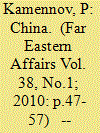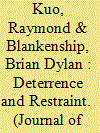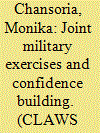| Srl | Item |
| 1 |
ID:
095200


|
|
|
|
|
| Publication |
2010.
|
| Summary/Abstract |
The article examines military diplomacy and its role in China's present-day military policy in the context of wide-scale security measures serving to create a favorable international environment for implementing the country's national development strategy.
|
|
|
|
|
|
|
|
|
|
|
|
|
|
|
|
| 2 |
ID:
183145


|
|
|
|
|
| Summary/Abstract |
Multinational military exercises are among the most notable demonstrations of military cooperation and intent. On average, one is initiated every 8.9 days. But it has often been argued that joint military exercises (JMEs) increase the risk of war. Using a relational contracting approach, we claim that formal military alliances mediate the effect of JMEs. Exercises and alliances serve complementary functions: The former allows targeted responses to military provocations by adversaries, while the latter provides institutional constraints on partners and establishes a partnership’s overall strategic limitations. In combination, alliances dampen the conflict escalation effects of exercises, deterring adversaries while simultaneously restraining partners. We test this theory using a two-stage model on directed dyadic data of JMEs from 1973 through 2003. We find that JMEs in general do not escalate conflict, and that JMEs conducted with allies in particular reduce the probability of conflict escalation.
|
|
|
|
|
|
|
|
|
|
|
|
|
|
|
|
| 3 |
ID:
139171


|
|
|
|
|
| Summary/Abstract |
The broad generic characterisation of Confidence-Building Measures (CBMs) is of them being a set of unilateral, bilateral, or multilateral procedural actions that primarily are put in place to decrease military tensions between state actors (nation-states) before, during or after actual conflict. States with security-related differences that could potentially lead to conflict should encourage channels to communicate regularly through consultative mechanisms with transparency measures that foster greater candidness of military cooperation. These could include pre-notification requirements, military exercises and related operating procedures. In today’s conflict-ridden world, CBMs serve as an effective tool to make a breakthrough towards the larger goal of conflict resolution. The aim of CBMs is to help build a working trust by addressing the more amenable issues by means of substantive negotiations, which, in turn, could potentially allow parties to address the more contentious aspects of a conflict.1 CBMs, thus, are not necessarily an end in themselves, but rather useful steps to negotiate and implement processes that could become bridges to reduce conflict situations between states.
|
|
|
|
|
|
|
|
|
|
|
|
|
|
|
|